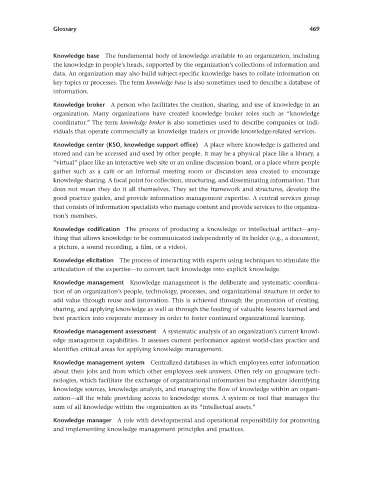Page 486 -
P. 486
Glossary 469
Knowledge base The fundamental body of knowledge available to an organization, including
the knowledge in people ’ s heads, supported by the organization ’ s collections of information and
data. An organization may also build subject-specifi c knowledge bases to collate information on
key topics or processes. The term knowledge base is also sometimes used to describe a database of
information.
Knowledge broker A person who facilitates the creation, sharing, and use of knowledge in an
organization. Many organizations have created knowledge broker roles such as “ knowledge
coordinator. ” The term knowledge broker is also sometimes used to describe companies or indi-
viduals that operate commercially as knowledge traders or provide knowledge-related services.
Knowledge center (KSO, knowledge support offi ce) A place where knowledge is gathered and
stored and can be accessed and used by other people. It may be a physical place like a library, a
“ virtual ” place like an interactive web site or an online discussion board, or a place where people
gather such as a caf é or an informal meeting room or discussion area created to encourage
knowledge sharing. A focal point for collection, structuring, and disseminating information. That
does not mean they do it all themselves. They set the framework and structures, develop the
good practice guides, and provide information management expertise. A central services group
that consists of information specialists who manage content and provide services to the organiza-
tion ’ s members.
Knowledge codifi cation The process of producing a knowledge or intellectual artifact — any-
thing that allows knowledge to be communicated independently of its holder (e.g., a document,
a picture, a sound recording, a fi lm, or a video).
Knowledge elicitation The process of interacting with experts using techniques to stimulate the
articulation of the expertise — to convert tacit knowledge into explicit knowledge.
Knowledge management Knowledge management is the deliberate and systematic coordina-
tion of an organization ’ s people, technology, processes, and organizational structure in order to
add value through reuse and innovation. This is achieved through the promotion of creating,
sharing, and applying knowledge as well as through the feeding of valuable lessons learned and
best practices into corporate memory in order to foster continued organizational learning.
Knowledge management assessment A systematic analysis of an organization ’ s current knowl-
edge management capabilities. It assesses current performance against world-class practice and
identifi es critical areas for applying knowledge management.
Knowledge management system Centralized databases in which employees enter information
about their jobs and from which other employees seek answers. Often rely on groupware tech-
nologies, which facilitate the exchange of organizational information but emphasize identifying
knowledge sources, knowledge analysis, and managing the fl ow of knowledge within an organi-
zation — all the while providing access to knowledge stores. A system or tool that manages the
sum of all knowledge within the organization as its “ intellectual assets. ”
Knowledge manager A role with developmental and operational responsibility for promoting
and implementing knowledge management principles and practices.

